- Home
- Watercolor Pencils
- how to use watercolor pencils
How to Use Watercolor Pencils
When it comes to art supplies, watercolor pencils are a fantastic choice for artists looking to explore their creative potential. These versatile tools offer a wide range of possibilities, allowing you to effortlessly switch between wet and dry techniques.
Let me guide you through the process of how to use watercolor pencils effectively.
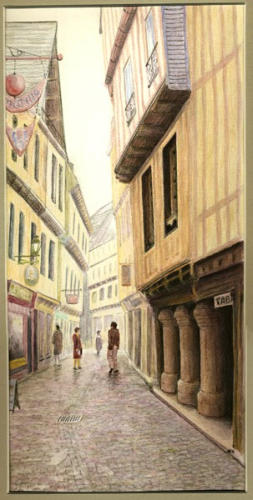
Colored pencils have been around since the 1800s, but the ones we have now are far superior to their original counterparts. Made with pigments, clays, wax, and binders, these modern versions come in a wide range of vibrant hues and shades to suit any artist's palette and preferences.
One of the great advantages of watercolor pencils is their non-toxic and non-messy nature. Unlike traditional watercolor techniques, they don't require additives, solvents, or water-soluble mediums to achieve the desired effect. They are conveniently ready to use straight from the pack.
One great way to get started is by checking out a simple exercise that we've prepared for you. It's a step-by-step guide where you'll learn how to use these pencils by painting a pair of pears. This exercise is perfect for beginners and will give you a solid foundation to build upon.
How to use watercolor pencils for beginners
To make the most of your experience, here are a few basic tips to keep in mind:
- Start with a light hand: This allows you to build up the colors gradually and achieve smooth blends. Heavy pressure can damage your paper.
- Experiment with different surfaces: Don't limit yourself to just paper. Try using these pencils on canvas, wood, or any other textured surface. Each surface will yield unique results, so don't be afraid to explore and see what works best for your style.
- Mix and match colors: The beauty of these pencils lies in the array of colors at your disposal. But don't be afraid to mix and match them to create new and exciting combinations.
- Practice blending techniques: Blending is one of the key techniques to master with these pencils, and you don't have to use water! Try using a blending stump, cotton swab, or even your finger to gently blend and soften the edges between colors. This will give your artwork a more polished and professional look.
- Take your time: Remember, creating art is a journey, not a race. Take the time to explore and experiment with these pencils. Enjoy the process and don't be afraid to make mistakes – they often lead to unexpected discoveries.
Watercolor pencil brands
When it comes to watercolor pencils, some manufacturers provide artists with a range of hues that are also available in their wax or oil-based pencil lines.
However, it's important to note that there is a difference in the binding of these pencils. As a result, the water-soluble pencils may not move as smoothly on the paper.
Now, you might be wondering, what does this mean for your artwork? Well, fear not! Despite the difference in binding, you will still be able to achieve the same levels of transparency with your watercolor pencils.
Faber Castell produce their Polychromos and Albrecht Durer (watercolor) pencils in the same range of colors.
Caran d'Ache offer the same colours in their Pablo and Supracolor (watercolor) pencils.
If you find yourself working with a tight budget, I have some good news for you! Starting with a small selection of colors is a viable option.
You can use these colors dry, just like ordinary colored pencils, and layer them to create a wider range of shades and hues.
Then if you need a specific color that isn't in your set, don't worry! By adding water to your watercolor pencils, you can easily mix any color you need for your artwork.
What if you want to adjust the colors or values later on? Well, with watercolor pencils, that's not a problem. Once they have dried, you can actually work on top of them. This means you can go back and make modifications to your drawing, refining the colors and values as needed with normal colored pencils.
And if you made a mistake?
You can lift the pigment from the surface when it is in is the original dry state using a kneaded eraser.
If you don't have an eraser handy or if the pigment is particularly stubborn, you have a couple of other options.
- Low-tack tape, such as painter's tape, can be pressed onto the pigment and then lifted away, taking some of the pigment with it.
- Alternatively, you can use a product called WhiteTac, which is stickier and softer than BlueTac. This makes it more effective at lifting pigment. If you're having trouble finding WhiteTac locally, you can easily order it online.
How to use watercolor pencils with a brush
Creating watercolor effects using water soluble colored pencils can be as simple as drawing with them on paper then wetting the pigment with a damp brush. Peter used this technique in his demonstration of the watercolor pencil painting showing Brokken Bridge.
However, the imaginative artist will find new ways to use this product to produce breathtaking, vibrant results!
Some artists will mix colors by wetting the tip of the pencil with the brush and pushing the pigment around on the palette with water; others will dip the brush directly onto the water then apply the pigment to the paper surface. (Peter does not recommend this latter process!)
Water damages the integrity of the pencil core and wetting this will also end up being wasteful. This is because if you apply pressure after wetting it, the pencil is likely to snap and will need to be sharpened more often.
Often the first thing you will notice when you add water is a marked increase in color strength. Therefore, it is a wise move to test out your pencils on scrap paper first. Applying a light layer alongside a heavy layer will allow you to see how the pigments react to water.
Keep your brush moist rather than wet, wiping off any surplus water before applying it to your paper. Using the correct watercolour brush is important, so we added a page to help you pick the right one for the task.
You will discover that as you become more experienced, there are so many different ways to create stunning effects when learning how to use watercolour pencils!
But let's start with the basics.
Just as with wax pencils, pressure is important.
Using a light hand when applying layers of pigment to your paper will allow you to dissolve the colours fully and smoothly. If, on the other hand, you press hard you could find the lines difficult to blend out as the pigment will have worked its way into the surface of the paper. Even using lots of water may not completely eliminate the harsh lines.
If, when you add water, you find that you have laid down too much pigment to begin with, you can soak up some of the excess by gently blotting with kitchen paper or a natural sponge.
Depending on the quality of your pencils you may find that you need to scrub a little with your brush to loosen the pigment. This is why we don't recommend you use your best sable brushes!
Ignoring for the moment, Derwent Inktense, the pigment from other water soluble pencils can be rewet and moved around or lifted from the paper surface. If you add further layers to dried passages of your painting, the existing color can lift, so take care.
Some colours stain more than others, and you will need to ensure you remove the surplus as quickly as possible if you make a mistake. In the sample below, I removed an area with tissue to create a soft fluffy cloud effect on the blue sky background.
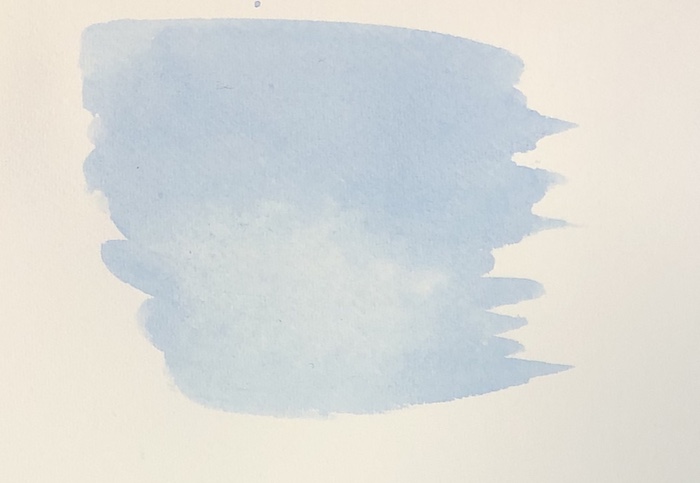
Derwent Inktense are different
Inktense pencils contain a water soluble ink rather than watercolour pigment, and once water has been added to this and it has dried, it is permanent. This can be an advantage or disadvantage, depending on the art you are trying to produce.
The color obtained from Inktense cannot be called subtle! The samples below show how intense the yellow becomes after the addition of water.
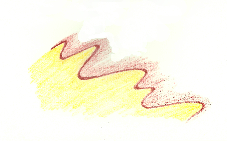
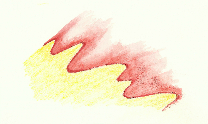
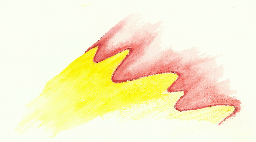
How to use watercolour pencils with a pad of tissue
Instead of using a brush to activate pencil already on the paper you can try the following technique. This is ideal if you want a softer, more subtle effect.
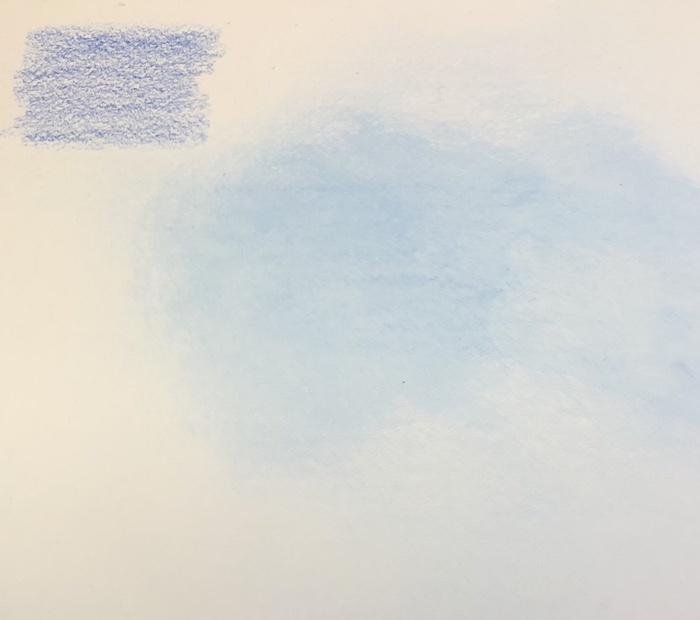 Staedtler Karat pencil applied dry then worked gently with a pad of tissue paper
Staedtler Karat pencil applied dry then worked gently with a pad of tissue paperUsing the side of the pencil softly add a layer of pigment to your drawing. Then lightly moisten a tissue or kitchen paper and gently dab it onto the dry pigment. Some of the colour will be removed, leaving a wash of dappled colour behind.
The texture that this method creates can be used to affect in skies, rough walls, distant trees or greenery, in fact, anything where you don't want a smooth even coverage.
This is a useful way to learn how to use watercolor pencils on non-traditional papers. Less water is required and therefore lighter weight papers are less likely to warp.
If you have a fine mist spray bottle you can introduce a small amount of water to the dry pigment in this manner, followed by dabbing with the kitchen paper. Some pigment will dissolve, while other areas will remain dry. This can produce a convincing texture for gravel on a path.
How to use watercolor pencils by shaving the pigment
Using a palette
After first sharpening your pencil to a long point, you can take a craft knife or scalpel and scrape the exposed pigment into a dish. Be careful not to get any wood shavings in the dish. Then add water to the shavings to make a flat wash of colour, similar to pan watercolor paints.
Why not just use the paint?
Have you ever mixed different paints to get just the right hue and then found you didn't mix enough to complete the sky or other area of your painting? Not a problem if you pick a single colored pencil in your desired hue!
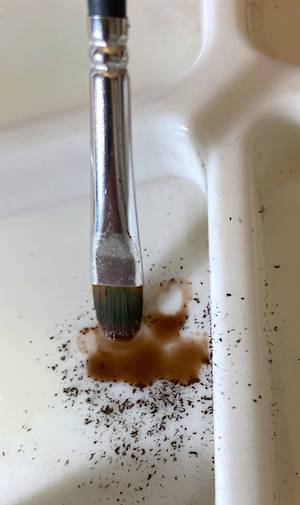
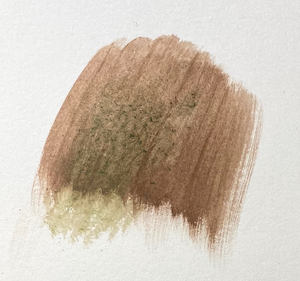
In this example, I shaved the brown pencil into a palette well, added water and painted it onto the paper. As it was drying, I drew in the plank lines and some wood grain texture with the pencil tip. After it had completely dried, I sprinkled green shavings onto the painting and used a damp brush to push them into the surface, giving an aged effect to the wood.
Creating floral textures
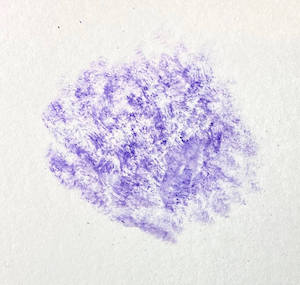
For the distant purple flowers in this next example, I shaved the pencil tip onto the paper and used a slightly damp filbert brush to press the pigment into the surface.
This produces a random effect, ideal for distant elements such as flower beds or trees. Further color can be glazed over the top, once dry, to add interest.
This was only a sample, but if I wanted to keep the shavings in one place I would cover the rest of the drawing with protective sheets and only remove it once the work had dried.
Creating rock textures
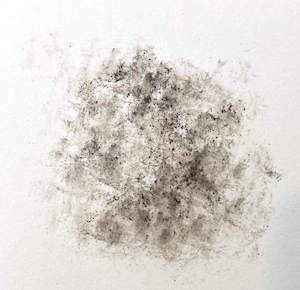
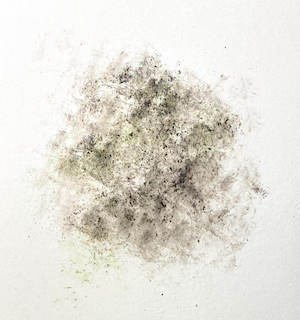
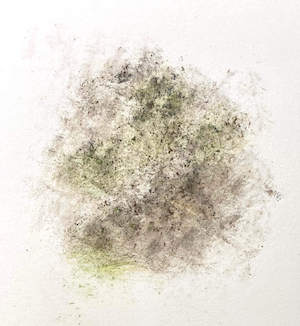
The photographs above show how to use watercolor pencils to create rocks.
I started with dry paper and grey/brown shavings. I used the damp filbert brush to squash them into the paper, rotating the brush, so I didn't get a repeating pattern of strokes. I then added green shavings to add a suggestion of moss forming on the rocks, and repeated the damp brush technique.
To complete the effect, I used a dry pencil tip to emphasize the area that seemed darker, forming a shadow on the underside of the rock. I also used a light grey pencil tip to fill in blank areas in the top section of the rock.
Using a makeup applicator
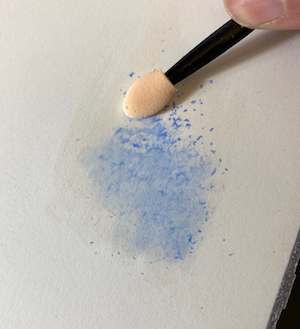
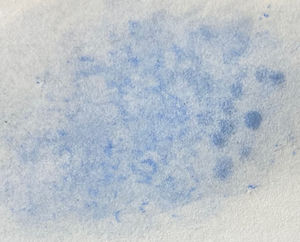
Another alternative to a brush is a sponge makeup applicator. Here I wet the paper first, then dropped the shavings onto the wet surface. I then moved them around to blend them softly, but randomly, into the painting. This is fun as you never know what sort of texture you are going to end up with.
Beware cheaper brands of watercolour pencils
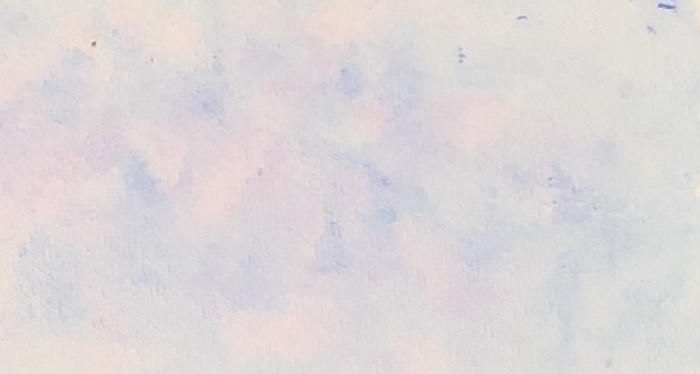
Interestingly when I experimented with shaving color from a cheaper brand of pencil direct onto wet paper, the different colours that made up the core separated. This gave a very pretty mottled multicoloured effect. This was a Sapphire Blue Arteza pencil!
How to use watercolour pencils using a paper palette
Pencil pigment can be laid down onto sanded paper, or rough watercolour paper, where it can then act as a palette.
Peter uses a 400 grit Hermes paper which is light gray. You could use any suitable fine grit paper found in the DIY superstore which is light in value and waterproof, Rub dry pigment from your pencil points (this will keep your pencils sharp at the same time) and then apply a damp brush to the block of colour. You can even mix two or more colors on this palette before adding the pigment to your painting.
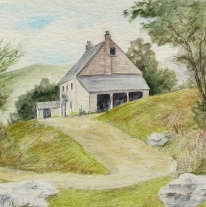 Watercolour pencil sketch of Welsh farm 5.5 ins square
Watercolour pencil sketch of Welsh farm 5.5 ins square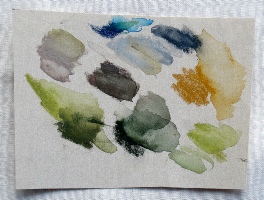 Hermes P400 grit paper used as a palette for pencil pigment
Hermes P400 grit paper used as a palette for pencil pigmentHow to use watercolor pencils when travelling ultra light
If you enjoy painting en plein air, instead of taking a tin of paints or a selection of pencils, prepare a palette as above with the colours you may need. This will act as your paintbox. Add a surface to paint on and a small brush into a lidded tin, along with a graphite pencil if needed. After emptying your tin on location, fill it with a little water and start painting.
